|
|
|

|
|
2011 (vol. 11)
|
|
Memoir 2 [2011]: The Early Aptian (Early Cretaceous) ammonites from the Aralar Mountains, Basque-Cantabrian Basin, Northern Spain, by
Seyed Naser RAISOSSADAT.-
Format [HTML] or [PDF
1,498 KB]
Reference: [CG2011_M02]
DOI:
10.4267/2042/45794
Lang.:
|
|
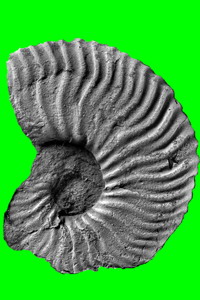 Abstract: The Aralar Mountains located in northern Spain exposes a 983-m-thick succession of sediments of Early Aptian age. The lithological succession evolves from lutites, marls, and calcarenites of the Errenaga Formation to rudist micritic limestones of the Sarastarri Formation, and finally marls, lutites, and sandstones of the Lareo Formation. Based on ammonite assemblage faunas, the Deshayesites oglanlensis, D. weissi, D. deshayesi, and Dufrenoyia furcata biozones have been identified. A transition between the deshayesi and furcata zones with the co-occurrence of the ammonite genera Deshayesites and Dufrenoyia is described in the Aralar succession and is currently unique. The ammonites are described here and correlations are made with other Tethyan regions. Abstract: The Aralar Mountains located in northern Spain exposes a 983-m-thick succession of sediments of Early Aptian age. The lithological succession evolves from lutites, marls, and calcarenites of the Errenaga Formation to rudist micritic limestones of the Sarastarri Formation, and finally marls, lutites, and sandstones of the Lareo Formation. Based on ammonite assemblage faunas, the Deshayesites oglanlensis, D. weissi, D. deshayesi, and Dufrenoyia furcata biozones have been identified. A transition between the deshayesi and furcata zones with the co-occurrence of the ammonite genera Deshayesites and Dufrenoyia is described in the Aralar succession and is currently unique. The ammonites are described here and correlations are made with other Tethyan regions.
|
|
Online since December 31, 2011
|
|
Article 5 [2011]: Xenobrochus norfolkensis (Brachiopoda: Dyscoliidae), a new species from the Norfolk Ridge, New Caledonia, South-West Pacific, by Maria Aleksandra BITNER.-
Format [HTML] or [PDF
2,151 KB]
Reference: [CG2011_A05]
DOI: 10.4267/2042/45792
Lang.:
|
|
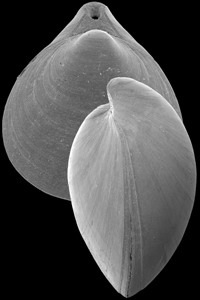 Abstract: The genus Xenobrochus, with the type species Gryphus africanus Cooper,
1973, was erected for short-looped brachiopods of small size, rectimarginate and having a loop with anteriorly convex transverse band. A new species of Xenobrochus, X. norfolkensis sp. nov. has been identified in the material collected during the French cruises SMIB 8, NORFOLK 1 and NORFOLK 2 to the Norfolk Ridge, New Caledonia, SW Pacific. This species differs from those hitherto described in the absence of cardinal process and relatively wide outer hinge plates. The genus, represented now by nine species, has a distribution restricted to the Indian Ocean and West Pacific. Abstract: The genus Xenobrochus, with the type species Gryphus africanus Cooper,
1973, was erected for short-looped brachiopods of small size, rectimarginate and having a loop with anteriorly convex transverse band. A new species of Xenobrochus, X. norfolkensis sp. nov. has been identified in the material collected during the French cruises SMIB 8, NORFOLK 1 and NORFOLK 2 to the Norfolk Ridge, New Caledonia, SW Pacific. This species differs from those hitherto described in the absence of cardinal process and relatively wide outer hinge plates. The genus, represented now by nine species, has a distribution restricted to the Indian Ocean and West Pacific.
|
|
Online since December 31, 2011
|
|
Letter 6 [2011]: The sauropod dinosaur Cetiosaurus OWEN in the Bathonian (Middle Jurassic) of the Ardennes (NE France): insular, but not dwarf, by Eric BUFFETAUT, Bernard GIBOUT, Isabelle LAUNOIS & Claude DELACROIX.-
Format [HTML] or [PDF
389 KB]
Reference: [CG2011_L06]
DOI: 10.4267/2042/43897
Lang.:
|
|
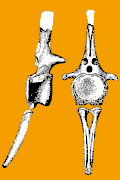 Abstract: A chevron bone from a Lower Bathonian oolitic limestone in the Ardennes (NE France) is referred to the sauropod dinosaur Cetiosaurus Owen, previously known from the Middle Jurassic of England, on the basis of its rod-like distal end. This is the first well attested occurrence of Cetiosaurus in France. The presence of Cetiosaurus remains in the Bathonian of both Oxfordshire and the Ardennes is explainable by the fact that these regions were situated on the margin of the London-Brabant Massif land area, on which sauropod populations apparently lived. Contrary to the condition observed in other sauropods found in insular environments, there is no evidence of dwarfism in Cetiosaurus from the London-Brabant Massif, probably because this emergent area was connected to the much larger Fenno-Scandian Shield. Abstract: A chevron bone from a Lower Bathonian oolitic limestone in the Ardennes (NE France) is referred to the sauropod dinosaur Cetiosaurus Owen, previously known from the Middle Jurassic of England, on the basis of its rod-like distal end. This is the first well attested occurrence of Cetiosaurus in France. The presence of Cetiosaurus remains in the Bathonian of both Oxfordshire and the Ardennes is explainable by the fact that these regions were situated on the margin of the London-Brabant Massif land area, on which sauropod populations apparently lived. Contrary to the condition observed in other sauropods found in insular environments, there is no evidence of dwarfism in Cetiosaurus from the London-Brabant Massif, probably because this emergent area was connected to the much larger Fenno-Scandian Shield.
|
|
Online since October 10, 2011
|
|
Letter 5 [2011]: Evolution of a dense outer protective tube layer in serpulids (Polychaeta, Annelida), by Olev VINN & Elena K. KUPRIYANOVA.-
Format [HTML] or [PDF
1,145 KB]
Reference: [CG2011_L05]
DOI: 10.4267/2042/43896
Lang.:
|
|
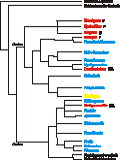 Abstract: Although the walls of most serpulid tubes are homogeneous, tubes of certain species may contain up to four ultrastructurally distinct layers. Some of these layers are made of densely packed large crystals and others are composed of sparsely packed fine crystals. In almost all (16 of 17) examined species having layered tubes, the dense layer is located in the outer wall part and the layer(s) composed of fine and relatively sparsely packed crystals are positioned in the inner wall part. Two species have transparent tube walls made entirely of densely packed crystals. Fossil serpulid tubes with dense outer layers (DOL) are known from the Late Cretaceous (Pentaditrupa subtorquata) and the Eocene (Pyrgopolon cf.
mellevillei and Rotularia spirulaea). DOL gives a characteristic smooth shiny appearance to the tube surface and presumably evolved as an adaptation against drilling predation by gastropods and to delay shell dissolution
in the waters of the deep-sea under-saturated with calcium carbonate. Abstract: Although the walls of most serpulid tubes are homogeneous, tubes of certain species may contain up to four ultrastructurally distinct layers. Some of these layers are made of densely packed large crystals and others are composed of sparsely packed fine crystals. In almost all (16 of 17) examined species having layered tubes, the dense layer is located in the outer wall part and the layer(s) composed of fine and relatively sparsely packed crystals are positioned in the inner wall part. Two species have transparent tube walls made entirely of densely packed crystals. Fossil serpulid tubes with dense outer layers (DOL) are known from the Late Cretaceous (Pentaditrupa subtorquata) and the Eocene (Pyrgopolon cf.
mellevillei and Rotularia spirulaea). DOL gives a characteristic smooth shiny appearance to the tube surface and presumably evolved as an adaptation against drilling predation by gastropods and to delay shell dissolution
in the waters of the deep-sea under-saturated with calcium carbonate.
|
|
Online since October 10, 2011
|
|
Letter 4 [2011]: Aptian ammonites of Abu Dhabi (United Arab Emirates), by Robert BUSNARDO & Bruno GRANIER.-
Format [HTML] or [PDF
2,150 KB]
Reference: [CG2011_L04]
DOI: 10.4267/2042/43895
Lang.:
|
|
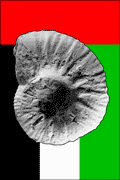 Abstract: The identification of some twenty ammonite fragments from oil wells drilled in offshore Abu Dhabi revealed the presence of six Aptian genera: Cheloniceras, Epicheloniceras, Gargasiceras, Colombiceras, Pseudohaploceras, and Macroscaphites. These ammonites indicate the Furcata Zone and the succeeding Martini Zone. The Gargasian age of the upper part (HST) of the Shu'aiba as well as that of the whole of the Bab are thus firmly established. Abstract: The identification of some twenty ammonite fragments from oil wells drilled in offshore Abu Dhabi revealed the presence of six Aptian genera: Cheloniceras, Epicheloniceras, Gargasiceras, Colombiceras, Pseudohaploceras, and Macroscaphites. These ammonites indicate the Furcata Zone and the succeeding Martini Zone. The Gargasian age of the upper part (HST) of the Shu'aiba as well as that of the whole of the Bab are thus firmly established.
|
|
Online since October 10, 2011
|
|
Letter 3 [2011]: Source and evolution of the clinopyroxenes in the Loire and Seine basins (France) based on grain morphology and color, by Robert ÉTIENNE & Jean-Pierre LARUE.-
Format [HTML] or [PDF
439 KB]
Reference: [CG2011_L03]
DOI: 10.4267/2042/43894
Lang.:
|
|
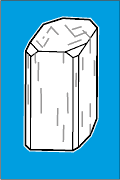 Abstract: Variation in the characteristics (color, morphology) of clinopyroxene grains (CPX) in alluvial deposits and other surficial formations in the Loire valley, the Gâtinais and the Beauce show that many are pristine and come directly from recent volcanic eruptions, whereas weathered grains, clearly reworked, come from erosion of Cenozoic and Pleistocene volcanic rocks of the French Massif Central. After deposition, the CPX have been increasingly altered by longer exposures. Weathering of brown CPX yields paler minerals which are greenish-brown, colourless or two-coloured. Similarly, the CPX found in the Seine basin are from recent volcanic ash or old Sologne deposits, and not from Loire alluvial deposits, so that a Pleistocene palaeo-Loire-Seine river is improbable. Abstract: Variation in the characteristics (color, morphology) of clinopyroxene grains (CPX) in alluvial deposits and other surficial formations in the Loire valley, the Gâtinais and the Beauce show that many are pristine and come directly from recent volcanic eruptions, whereas weathered grains, clearly reworked, come from erosion of Cenozoic and Pleistocene volcanic rocks of the French Massif Central. After deposition, the CPX have been increasingly altered by longer exposures. Weathering of brown CPX yields paler minerals which are greenish-brown, colourless or two-coloured. Similarly, the CPX found in the Seine basin are from recent volcanic ash or old Sologne deposits, and not from Loire alluvial deposits, so that a Pleistocene palaeo-Loire-Seine river is improbable.
|
|
Online since October 10, 2011
|
|
Memoir 1 [2011]: The "Theoi Marls" of
Pamproux (Deux-Sèvres, France), Antecedens sub-zone (Middle Oxfordian,
Plicatilis Zone): faunal diversity and discovery of new ammonite species, by
Philippe QUEREILHAC & Yvon GUINOT.-
Format [HTML] or [PDF
3,154 KB]
Reference: [CG2011_M01]
DOI:
10.4267/2042/42331
Lang.:
|
|
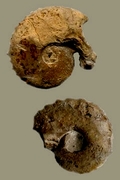 Abstract: Two road cuts at Doux and Pamproux in the Department of Deux Sèvres (Poitoux, France) exposed the base of the middle Oxfordian (Plicatilis Zone). Only the Pamproux section (on the Pampr'oeuf factory site) was studied in detail. There, the Plicatilis Zone is represented only by the Antecedens sudzone. Collections were made in situ and from rubble consisting solely of marls from the Antecedens Sub-zone. Sediment washing resulted in the collection of a very large number of very diversified and extremely small fossils. So a great number of individuals of two new species of Taramelliceratinae were discovered, along with two new species of "Glochiceras", their adult forms very different in size, resembling nothing so much as Ochetoceras (Ochetoceras) canaliculatum (von Buch,
1831) in the morph subclausum [m] Oppel, 1863. The sub-family Taramelliceratinae dominates the ammonite
fauna. Abstract: Two road cuts at Doux and Pamproux in the Department of Deux Sèvres (Poitoux, France) exposed the base of the middle Oxfordian (Plicatilis Zone). Only the Pamproux section (on the Pampr'oeuf factory site) was studied in detail. There, the Plicatilis Zone is represented only by the Antecedens sudzone. Collections were made in situ and from rubble consisting solely of marls from the Antecedens Sub-zone. Sediment washing resulted in the collection of a very large number of very diversified and extremely small fossils. So a great number of individuals of two new species of Taramelliceratinae were discovered, along with two new species of "Glochiceras", their adult forms very different in size, resembling nothing so much as Ochetoceras (Ochetoceras) canaliculatum (von Buch,
1831) in the morph subclausum [m] Oppel, 1863. The sub-family Taramelliceratinae dominates the ammonite
fauna.
|
|
Online since July 5, 2011
|
|
Letter 2 [2011]: Computer-aided identification of the Archaeocyatha genera now available
online, by Adeline KERNER, Régine VIGNES LEBBE & Françoise DEBRENNE.-
Format [HTML] or [PDF
965 KB]
Reference: [CG2011_L02]
DOI: 10.4267/2042/42329
Lang.:
|
|
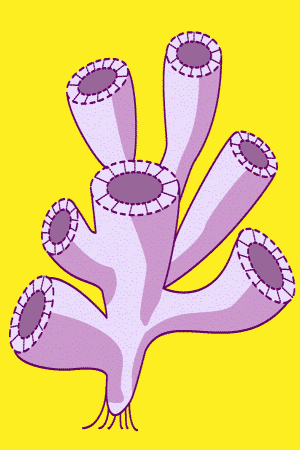 Abstract: The Archaeocyatha are a key group in several of the many discrete disciplines that together make feasible a valid history of the Earth: they are the oldest of the calcified sponges, the first metazoans to build reefs (in association with
calcimicrobes), are characteristic fossils used for the biozonation of the first,
pre-trilobitic Cambrian stage (Tommotian)… To date, a valid key to their identification has not been available, so a tool for that purpose has been devised: it was created using the software XPER2, and is now available free, online. Published in English, the knowledge base includes the 307 valid described genera identified by 120 descriptors (85 morphological and ontogenetic, 8 stratigraphic and geographic and 27 taxonomic). A key to identification is supplemented by detailed descriptive cards with images of type specimens of each genus and details of their morphology that aid identification. Abstract: The Archaeocyatha are a key group in several of the many discrete disciplines that together make feasible a valid history of the Earth: they are the oldest of the calcified sponges, the first metazoans to build reefs (in association with
calcimicrobes), are characteristic fossils used for the biozonation of the first,
pre-trilobitic Cambrian stage (Tommotian)… To date, a valid key to their identification has not been available, so a tool for that purpose has been devised: it was created using the software XPER2, and is now available free, online. Published in English, the knowledge base includes the 307 valid described genera identified by 120 descriptors (85 morphological and ontogenetic, 8 stratigraphic and geographic and 27 taxonomic). A key to identification is supplemented by detailed descriptive cards with images of type specimens of each genus and details of their morphology that aid identification.
|
|
Online since July 5, 2011
|
|
Article 4 [2011]: An outcrop with non-marine
ostracodes in the Early Eocene of Djebel Amour, central Saharian Atlas, Algeria:
taxonomy, palaeoecology and palaeobiogeography, by Fateh MEBROUK, Jean-Paul COLIN &
Fatima HENNACHE.-
Format [HTML] or [PDF
1,866 KB]
Reference: [CG2011_A04]
DOI: 10.4267/2042/42328
Lang.:
|
|
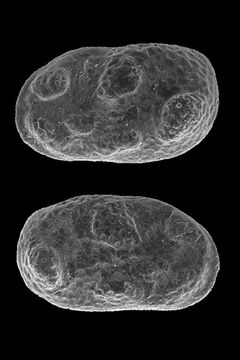 Abstract: An outcrop with non-marine ostracods in the Early Eocene of
Djebel Amour, an outcrop well dated by a rich charophyta microflora characterizing the Peckichara disermas Zone of the Early Eocene (Lower Ypresian = Ilerdian), has yielded an interesting non-marine ostracode fauna in the Djebel Amour, Western Saharian Atlas, in Algeria. This fauna is characterized by the dominance of the genus Neocyprideis with the new species Neocyprideis meguerchiensis nov. sp., and the occasional occurrence of the genera Hemicyprideis, Perissocytheridea (P. algeriensis nov. sp.) and Limnocythere. It is the second discovery of the genus Neocyprideis in the Palaeogene of the African continent, the first one being in the Early Eocene of Senegal. The Neocyprideis are represented by 75 % of smooth and normally calcified carapaces, 20 % by reticulate-noded specimens and 5 % of only reticulate forms. This polymorphism suggests a marked seasonality with fluctuating salinity. The dominance of smooth and well calcified morphs indicates an environment with an equilibrium
Ca++ / Mg++, the reticulate morphs characterizing waters richer in
Mg++. The presence of noded-reticulate forms suggests seasonal influxes of organo-siliceous material from the continent and a salinity which could temporarily reach values lower or equal to 5 psu. Abstract: An outcrop with non-marine ostracods in the Early Eocene of
Djebel Amour, an outcrop well dated by a rich charophyta microflora characterizing the Peckichara disermas Zone of the Early Eocene (Lower Ypresian = Ilerdian), has yielded an interesting non-marine ostracode fauna in the Djebel Amour, Western Saharian Atlas, in Algeria. This fauna is characterized by the dominance of the genus Neocyprideis with the new species Neocyprideis meguerchiensis nov. sp., and the occasional occurrence of the genera Hemicyprideis, Perissocytheridea (P. algeriensis nov. sp.) and Limnocythere. It is the second discovery of the genus Neocyprideis in the Palaeogene of the African continent, the first one being in the Early Eocene of Senegal. The Neocyprideis are represented by 75 % of smooth and normally calcified carapaces, 20 % by reticulate-noded specimens and 5 % of only reticulate forms. This polymorphism suggests a marked seasonality with fluctuating salinity. The dominance of smooth and well calcified morphs indicates an environment with an equilibrium
Ca++ / Mg++, the reticulate morphs characterizing waters richer in
Mg++. The presence of noded-reticulate forms suggests seasonal influxes of organo-siliceous material from the continent and a salinity which could temporarily reach values lower or equal to 5 psu.
|
|
Online since July 5, 2011
|
|
Article 3 [2011]: Ostracods distribution in the
subsurface sediments of El-Guettiate Sebkha (Skhira, gulf of Gabes). Interest
for Holocene palaeoenvironmental reconstruction, by
Chahira ZAÎBI, Fekri KAMOUN, Pierre CARBONEL & Mabrouk MONTACER.-
Format [HTML] or [PDF
1,598 KB]
Reference: [CG2011_A03]
DOI: 10.4267/2042/42327
Lang.:
|
|
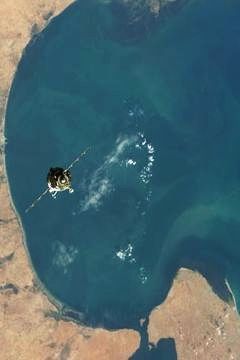 Abstract:
A quantitative and qualitative study of the ostracods from the SG1 and BSC2 cores
of El-Guettiate Sebkha of Skhira (southeastern Tunisia) has allowed the identification of different associations and the reconstruction of the Holocene palaeoenvironments. Ostracods, rich in species, provide three associations: (i)
a marine association containing Aurila prasina Barbieto-Gonzalez, 1971, Cushmanidea
elongata (Brady, 1868), Urocythereis oblonga (Brady, 1866), U.
favosa (Roemer, 1838) (coastal marine), Basselerites berchoni (Brady, 1869), Semicytherura incongruens (G.W. Müller, 1894), S.
paradoxa (G.W. Müller, 1894), S.
sella (Sars, 1866), S. ruggierii (Pucci, 1955), Carinocythereis carinata (Roemer, 1838)
and Paracytheridea depressa (G.W. Müller, 1894) (open
marine); (ii) lagoonal association, of variable salinity, comprising Xestoleberis aurantia (Baird, 1838), Leptocythere fabaeformis (G.W. Müller, 1894) and Cytherois fischeri (Sars, 1866); (iii) brackish estuarine association
subject to estuarine influence as indicated by Cyprideis torosa (Jones, 1850) and Loxoconcha elliptica Brady, 1868. The ostracods
from El-Guettiate Sebkha allow us to recognize discrete palaeoenvironments that can be grouped in three phases: i) the first (6595 ± 120 - 6055 ± 30 years BP) begins with an open lagoon rich in marine ostracods followed by an estuarine lagoon (towards 6595 years BP) characterized by the richness of brackish ostracods and high energy. In the last lagoonal environment (installed towards 6055 years BP), brackish species are dominant and associated with lagoonal taxa; ii) the second phase (6055 ± 30 years BP - 5150 ± 30 years BP)
is an estuarine lagoon, subject to a large marine influence in which brackish marine and lagoonal species are present
in the same percentages. In this environment, littoral drift currents were responsible for the genesis of sand
spits, the termination of environments and the dominance of brackish-water ostracods; iii) The last phase (5150 ± 50 years BP - recent)
represents a restricted lagoon (about 5150 years BP) and finally a brackish
lagoon evolved towards the sebkha environment under investigation here. This phase includes an unstable period with washover deposits resulting from an extreme climatic event. Abstract:
A quantitative and qualitative study of the ostracods from the SG1 and BSC2 cores
of El-Guettiate Sebkha of Skhira (southeastern Tunisia) has allowed the identification of different associations and the reconstruction of the Holocene palaeoenvironments. Ostracods, rich in species, provide three associations: (i)
a marine association containing Aurila prasina Barbieto-Gonzalez, 1971, Cushmanidea
elongata (Brady, 1868), Urocythereis oblonga (Brady, 1866), U.
favosa (Roemer, 1838) (coastal marine), Basselerites berchoni (Brady, 1869), Semicytherura incongruens (G.W. Müller, 1894), S.
paradoxa (G.W. Müller, 1894), S.
sella (Sars, 1866), S. ruggierii (Pucci, 1955), Carinocythereis carinata (Roemer, 1838)
and Paracytheridea depressa (G.W. Müller, 1894) (open
marine); (ii) lagoonal association, of variable salinity, comprising Xestoleberis aurantia (Baird, 1838), Leptocythere fabaeformis (G.W. Müller, 1894) and Cytherois fischeri (Sars, 1866); (iii) brackish estuarine association
subject to estuarine influence as indicated by Cyprideis torosa (Jones, 1850) and Loxoconcha elliptica Brady, 1868. The ostracods
from El-Guettiate Sebkha allow us to recognize discrete palaeoenvironments that can be grouped in three phases: i) the first (6595 ± 120 - 6055 ± 30 years BP) begins with an open lagoon rich in marine ostracods followed by an estuarine lagoon (towards 6595 years BP) characterized by the richness of brackish ostracods and high energy. In the last lagoonal environment (installed towards 6055 years BP), brackish species are dominant and associated with lagoonal taxa; ii) the second phase (6055 ± 30 years BP - 5150 ± 30 years BP)
is an estuarine lagoon, subject to a large marine influence in which brackish marine and lagoonal species are present
in the same percentages. In this environment, littoral drift currents were responsible for the genesis of sand
spits, the termination of environments and the dominance of brackish-water ostracods; iii) The last phase (5150 ± 50 years BP - recent)
represents a restricted lagoon (about 5150 years BP) and finally a brackish
lagoon evolved towards the sebkha environment under investigation here. This phase includes an unstable period with washover deposits resulting from an extreme climatic event.
|
|
Online since July 5, 2011
|
|
Article 2 [2011]: Difficulties in dating
Pleistocene marine levels using fossil mollusk shells: the Ouljian level on the
High Atlas shore, Morocco, by Abdelmajid
Choukri, Oum-Keltoum
HaKam
& Jean-Louis Reyss.-
Format [HTML] or [PDF
2,196 KB]
Reference: [CG2011_A02]
DOI:
10.4267/2042/39245
Lang.:
|
|
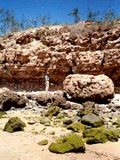 Abstract: In order to comprehend the difficulty of dating marine strata using samples of mollusks
shells and in an attempt to establish criteria that help in judging the validity of a
230Th /234U age determination, we present here the
results of a radioactive element analysis of some 80 samples of mollusk shells.
The shells were taken from fossil marine beaches between 4 and 8 meters above
current sea level. When compared with the Egyptian shore of the Red Sea these levels
are taken to be related to climate stage 5 dated as about 122,000 years ago. The ages obtained are often
rejuvenated regardless of site, the incidence of calcite, the amount of uranium and the
relationships of 234U/238U. Abstract: In order to comprehend the difficulty of dating marine strata using samples of mollusks
shells and in an attempt to establish criteria that help in judging the validity of a
230Th /234U age determination, we present here the
results of a radioactive element analysis of some 80 samples of mollusk shells.
The shells were taken from fossil marine beaches between 4 and 8 meters above
current sea level. When compared with the Egyptian shore of the Red Sea these levels
are taken to be related to climate stage 5 dated as about 122,000 years ago. The ages obtained are often
rejuvenated regardless of site, the incidence of calcite, the amount of uranium and the
relationships of 234U/238U.
Unlike coral, mineralogical criteria cannot be used to select mollusk
shells unaffected by recrystallization, for present-day shells may be composed
of aragonite, others are calcitic, and others contain both minerals. In any case,
the rules concerning their effects of composition on radioactivity are as yet poorly
understood. With these problems in mind, we made multiple analyses on several
species of of mollusks, always collected from the same sites, in order to
understand progressive changes in the process of age rejuvenation and to
attempt eventually to determine systematic criteria providing information on the
validity of the calculated age. Possible mechanisms that may influence the
incorporation of uranium in rejuvenation have been conceived and are discussed.
|
|
Online since April 27, 2011
|
|
Discussion of the Article CG2010_A01, vol. 10, no. A01 [2011]: Discussion
of: Problems in the identity of "Crioceras" barremense Kilian, 1895 (Ancyloceratida, Late Barremian), and their proposed
resolution, by D. BERT et alii (CG2010_A01)
[Alternative title: The nomenclatural status and the acceptation
of the genus Barrancyloceras
VERMEULEN, 2000, and of
its type species], by Jean VERMEULEN.-
Format [HTML] or [PDF
165 KB]
Reference: [CG2010_A01R]
DOI:
10.4267/2042/39244
Lang.:
|
|
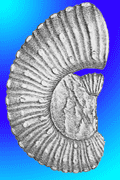 Abstract: This
work is a reply to the paper of Bert et
alii (2010) who contested the validity of the genus Barrancyloceras
and its type species. The answers and precisions brought up herein deal with: Abstract: This
work is a reply to the paper of Bert et
alii (2010) who contested the validity of the genus Barrancyloceras
and its type species. The answers and precisions brought up herein deal with:
- the nomenclatural status of Barrancyloceras
barremense (Kilian, 1895);
- the nomenclatural status of the genus Barrancyloceras
Vermeulen, 2000;
- the understanding of the species Barrancyloceras
barremense (Kilian, 1895);
- the value, as a subzone index species of subzone, of Barrancyloceras
barremense and B. alpinum.
|
|
Online since April 27, 2011
|
|
Letter 1 [2011]: The role of an internal organic tube lining in the biomineralization of serpulid tubes, by Olev VINN.-
Format [HTML] or [PDF
795 KB]
Reference: [CG2011_L01]
DOI:
10.4267/2042/38798
Lang.:
|
|
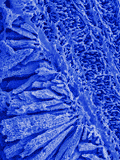 Abstract: Most
known serpulid tube ultrastructures in contact with an organic inner tube lining
do not show the direction in which they developed. But spherulitic prismatic
structures found in the innermost part of the tube wall of Recent Crucigera
websteri, C. zygophora, Floriprotis sabiuraensis, and Pyrgopolon
ctenactis indicate that the structure grew toward the organic inner tube
lining and also toward the tube's lumen. Similar directions of growth for this
structure are seen in Hydroides sp. from the Miocene of Austria. Growth
towards the tube's lumen is opposite to what one would expect if the organic
inner tube lining is being used as a scaffold for the biomineralization of CaCO3. Abstract: Most
known serpulid tube ultrastructures in contact with an organic inner tube lining
do not show the direction in which they developed. But spherulitic prismatic
structures found in the innermost part of the tube wall of Recent Crucigera
websteri, C. zygophora, Floriprotis sabiuraensis, and Pyrgopolon
ctenactis indicate that the structure grew toward the organic inner tube
lining and also toward the tube's lumen. Similar directions of growth for this
structure are seen in Hydroides sp. from the Miocene of Austria. Growth
towards the tube's lumen is opposite to what one would expect if the organic
inner tube lining is being used as a scaffold for the biomineralization of CaCO3.
|
|
Online since March 15, 2011
|
|
Article 1 [2011]: The Dichotomus Horizon: proposal for a new biochronologic unit of the Giraudi Zone of the Upper Barremian of southeastern France, and considerations regarding the genus Imerites Rouchadzé (Ammonoidea, Gassendiceratinae), by Didier BERT, Gérard DELANOY & Stéphane BERSAC.-
Format [HTML] or [PDF
786 KB]
Reference: [CG2011_A01]
DOI:
10.4267/2042/36091
Lang.:
|
|
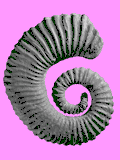 Abstract: Recent revisions of the genus Imerites Rouchadzé make it possible to introduce a new biochronologic horizon to define more precisely the lower boundary of the Giraudi Zone: the Dichotomus Horizon. Using the concept of 'interval zone', this new horizon maintains the current lower boundary of the Giraudi Zone as accepted by authors, and thus contributes to the stabilization of the Barremian zonal system. This stabilization is also strengthened by abandonment of the use of
"Crioceras" cristatus d'Orbigny (nomen dubium) that ought not be used as an index species in detriment of Imerites giraudi (Kilian). The classification, origin, and intraspecific variation of the genus Imerites Rouchadzé are examined. Abstract: Recent revisions of the genus Imerites Rouchadzé make it possible to introduce a new biochronologic horizon to define more precisely the lower boundary of the Giraudi Zone: the Dichotomus Horizon. Using the concept of 'interval zone', this new horizon maintains the current lower boundary of the Giraudi Zone as accepted by authors, and thus contributes to the stabilization of the Barremian zonal system. This stabilization is also strengthened by abandonment of the use of
"Crioceras" cristatus d'Orbigny (nomen dubium) that ought not be used as an index species in detriment of Imerites giraudi (Kilian). The classification, origin, and intraspecific variation of the genus Imerites Rouchadzé are examined.
|
|
Online since January 17, 2011
|
|
|
|